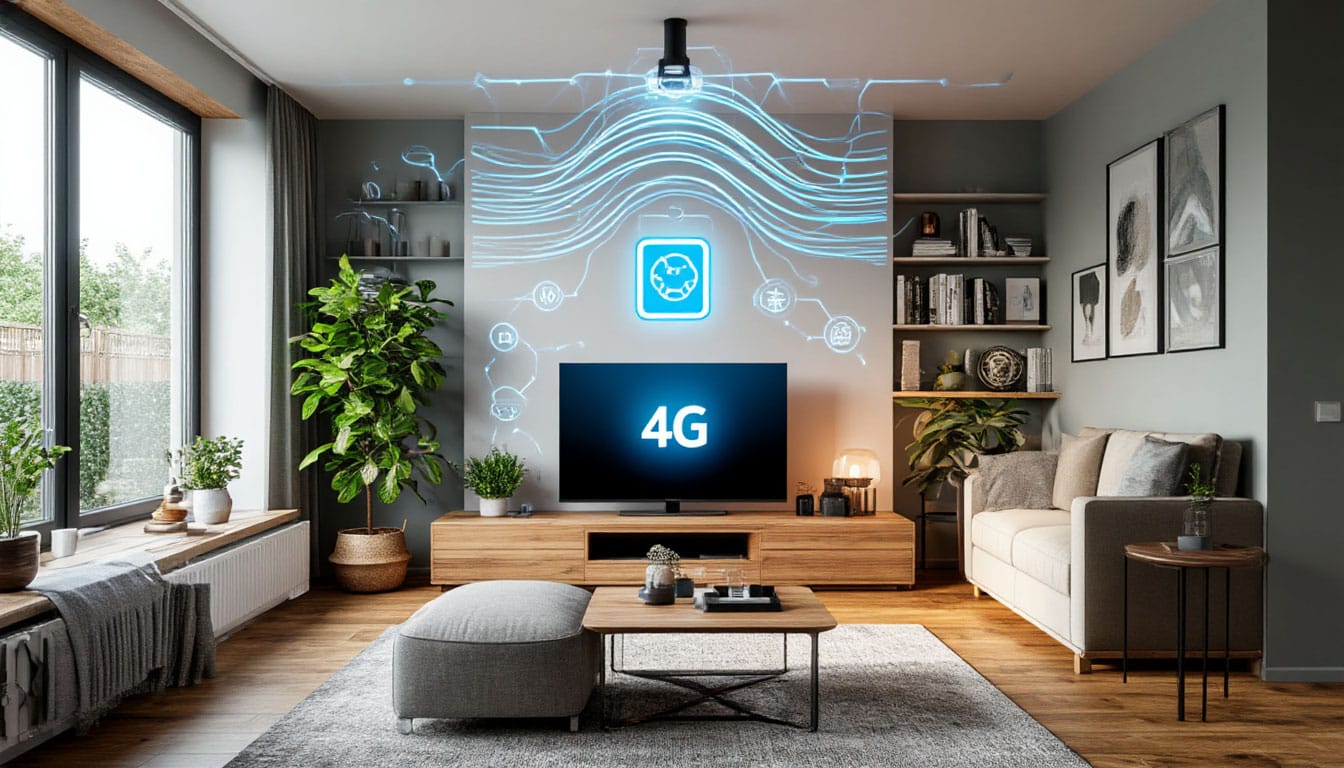
An automated system intelligently linking a plethora of devices is changing how we live modern life, and smart homes are at the forefront of this change. From entertainment and advanced security to smart lighting and HVAC services, an uninterrupted and strong internet connection supports all these features. While some parts have access to fiber optic and cable internet, a significant number of people, especially in rural and neglected areas, are forced to settle with the 4G LTE network as their main and only dependable fiberless internet source. Undoubtedly, the most frustrating part of the smart home experience is the weak, patchy, or non-existence 4G signal. 4G signal boosters for smart homes help solve these issues by providing reliable tools to increase 4G signal strength and make certain that all devices in the household are seamlessly connected.
The Pain Points of Weak 4G in a Connected Home: The List Goes Beyond Buffering
Take a step and analyze the precision to which poor 4G signal penetration affects all the aspects of the system; it goes beyond the inconvenience of a single video buffering. What about their implication on system security, reliability, and the general user experience? Check the following:
-
Unresponsive Smart Devices & Automation Failures
Imagine a scenario where your smart locks fail to engage due to a dropped connection, leaving your home vulnerable. Or, consider a scheduled smart irrigation system failing to activate, resulting in withered plants. These aren’t mere inconveniences; they represent a fundamental breakdown of the smart home’s core functionality. Furthermore, consider the cascade effect: a single point of failure (the weak signal) can trigger a chain of unexpected consequences across multiple interconnected devices. We’re talking about disrupted routines, energy inefficiencies, and potentially, even increased security risks. -
Compromised Real-Time Applications
Applications requiring real-time responsiveness, such as video conferencing, online gaming, and remote monitoring, become virtually unusable with a weak 4G connection. The latency and packet loss associated with a poor signal render these applications frustrating and ineffective. The reliance on cloud-based processing and services magnifies the impact of a fluctuating or unstable 4G signal. -
Security System Vulnerabilities & Delayed Response Times
A 4G signal that has been compromised is known to lower the security level of your home system. With late notifications caused by motion sensor malfunctioning, non-functioning security cameras, and your inability to supervise your property remotely could create easy targets for burglars. There is a time gap that is affecting the resident’s response to alerts as the events may not be prevented and security may be breached. An internet disruption that prevents home monitoring systems from functioning the way they should can be particularly dangerous to elderly or vulnerable people living alone. -
Disabled Productivity and Remote Work Effectiveness
The fact that a reliable internet connection is a non-negotiable prerequisite came when remote work became a widespread concept. Obstacles to free smooth riding to high productivity due to low 4G signal strengths are long-overdue deadlines, strained personal relationships, and finally, work-life balance. Except for some casual web surfing, the most common remote work uses are high data throughput and low latencies, both of which are, however, destroyed by poor 4G signal strength. -
Reduction on Battery Life
The disability of smart devices to connect to 4G constantly drains their battery. This results in the need for more frequent charging, reducing the longevity of power-supplied devices. In addition, this increases the maintenance cost associated with smart home devices.
In effect, a weak 4G signal is a choke point which restricts data transmission and disrupts the intricate network of interactions that make up a functional and pleasurable smart home experience.
Dissecting the Problem: Root Causes of Weak Indoor 4G Signals
Understanding the underlying causes of poor indoor 4G reception is paramount to selecting the appropriate solution. Several factors contribute to this issue:
- Attenuation Due to Building Materials
Building materials like reinforced concrete, brick, metal cladding, and low-emissivity (Low-E) windows are great obstacles to radio frequency (RF) signals. The aforementioned materials absorb and reflect 4G signals that reduce their strength as they propagate within a building. The type of material used and its thickness are directly proportional to the amount of signal attenuation experienced. For instance, a metal rooftop may completely eliminate 4G signals from certain areas of the house. - Distance and Obstructions from Cellular Towers
Naturally, the strength of the signal decreases with distance from the nearest cell tower. There are geographical hindrances to this propagation, such as hills, valleys, and dense forests. This situation is even more challenging in the urban setup as they create an “urban canyon” that blocks and scatters radio waves as these urban setups are densely populated with buildings. - Interference from Electronic Devices
Generally, because of the signal brought down by interference from foreign electronic devices generating noises on the same frequency, slight degradation can occur in the 4G. Practical examples include microwave ovens, and cordless phones, and poorly shielded electronic equipment can generate RF noise that leads to interruptions in cellular communication. - Network Congestion
Denser regions, especially during rush hours, witness a slowdown in data speeds and intermittent connectivity due to network congestion. This, in fact, does not mean a problem with signals but rather that the bandwidth available is unable to cater to the demand, rendering the perceived performance poorer. - Multipath Fading and Internal Reflection
4G signals inside the building reflect off walls and other surfaces and create multiple paths for the signal to reach the device. The reflected signals can reach the device out of sync with the direct signal causing either constructive or destructive interference leading to signal strength fluctuation. This phenomenon is termed multipath fading, creating “dead zones” inside the house.
Troubleshooting and Optimization: Steps to Improve Your 4G Connection
Once you’ve identified the likely causes of your connectivity woes, consider these troubleshooting steps before investing in a signal booster.
Optimize Device Placement
- Router/Hotspot Position: If you’re using a 4G router or mobile hotspot, experiment with different locations. Elevated positions near windows often provide better signal reception. Keep it away from walls with dense materials or major appliances.
- Individual Smart Devices: For static smart devices (e.g., security cameras, smart thermostats), relocate them closer to your 4G router or hotspot if possible.
Upgrade Your 4G Router/Hotspot
Older 4G routers might lack the latest technologies for signal processing and antenna design. Upgrading to a newer model with improved capabilities can often make a noticeable difference. Look for devices that support multiple frequency bands and carrier aggregation.
Optimize Your 4G Router/Hotspot Settings
Access your router’s settings through a web browser (refer to your router’s manual for instructions). Look for options to:
- Select the optimal frequency band: Experiment with different frequency bands (if your router allows) to see which provides the best performance in your area.
- Enable Quality of Service (QoS): Prioritize traffic for critical devices or applications, such as video conferencing or security cameras.
- Update Firmware: Ensure your router is running the latest firmware. Firmware updates often include performance improvements and bug fixes.
Consider External Antennas (If Supported)
Some 4G routers/hotspots allow you to connect external antennas. A directional antenna, properly aimed at the nearest cell tower, can significantly improve signal reception. Research antenna options compatible with your specific router model.
Manage Data Usage
Limit bandwidth-intensive activities during peak hours, if possible. Adjust video streaming quality settings to reduce data consumption. Review the data usage of individual smart devices and identify any that are consuming excessive bandwidth unnecessarily.
A 4G LTE signal booster specifically designed for smart homes is a device which can easily solve connectivity issues. Unlike any other device using Wi-Fi, it uses a reliable resource of internet connection to distribute and amplify the existing 4G signal of the cellular network throughout your house to all of your smart devices. It provides a better and more consistent 4G signal even in smart home environments.
Finding the Right 4G Signal Boosters for Smart Home UK
What do you need to pay special attention to when choosing the right 4G signal for your smart home? Check the list below:
- Coverage Area: Consider the coverage area you need to cover in your home. Smaller boosters are suitable for apartments, while larger ones are needed for multi-story homes.
- Frequency Bands: Ensure the booster supports the frequency bands used by your carrier compatibility (Verizon, AT&T, T-Mobile, etc.) in the UK.
- Decibel (dB) Gain: Look for a booster with a high decibel (dB) gain for maximum signal amplification.
Installation and Setup
Most 4G signal boosters for smart homes come with everything you need for self-installation, including an external antenna, internal antenna, coaxial cables, and power supply. Follow the installation guide provided with your booster for the best results.
Is a 4G Signal Booster the Right Choice?
Here are some questions to consider:
- Is Your Internet Primarily 4G-Based? If you heavily rely on a mobile hotspot or 4G as your primary internet source, a booster is a great investment.
- Do You Experience Frequent Dropped Calls or Slow Data Speeds? A booster can dramatically improve call quality and data speeds.
- Are You Struggling to Connect Smart Devices? A wireless signal amplifier for smart homes can improve connectivity for all your smart devices.
Future-Proofing with 5G Compatibility
As 5G technology becomes more widespread, consider a 5G compatibility booster that also supports 4G. This will ensure that your smart home remains connected for years to come.
An All-Encompassing Perspective on Smart Home Connectivity
With a wholesome approach, seamless connectivity in your smart home can be 4G powered. Start by identifying the root issues causing your connectivity problems. Next, make all troubleshooting options before putting a booster into consideration. Following this approach will pave the way for optimization of your 4G connection and ultimately result in unlocking the potential of your smart home. A signal booster is only one tool in a larger kit for creating solid connection; an informed and strategic approach is necessary.





















